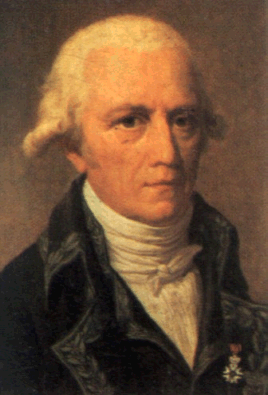
2 - Flore française
The microbial group name diatoms was inserted into the botanical
lexicon at the beginning of the 19th century through the tip of a French
quill. Jean Baptiste Lamarck (Figure 3) is well-known to every student
of biology -- probably less for his revolutionary studies of invertebrate
animals (1801, 1815-1822) and probably more for his pre-Darwinian ideas
about progressive, internally driven evolution modified by an inheritance
of acquired characteristics (1809). In contrast, he is relatively unknown
at present for his botanical studies, which occupied the first two decades
of his scientific life and carried him to the loftiest echelons of French
science during the Revolution (1789-1799). In 1778, as storm clouds
gathered around the head of Louis XVI and the Ancien Régime,
as Linnaeus, Voltaire and Rousseau passed on and A. P. de Candolle
was "sprung from a family in Provence" and Bory from one in
Aquitaine, and as Lavoisier was discovering the element silicon, after
nearly a decade of botanical study, the-34-year-old Lamarck published,
as the sole author, a monumental 3-volume Flora of France (Flore
françoise). [Note
2] A second edition, largely unaltered, was issued during
the Revolution, in 1795. Shortly thereafter, during the ascendancy of
Napoleon, Lamarck decided to issue a third edition. But now approaching
60 years old, having turned his scientific focus to zoology and concentrating
upon promoting his ideas about evolution among a resistent French scientific
corps, which had judged he had "peaked", he placed the work
of revising and expanding the Flore into the hands of a young
botanist, Augustin Pyrame de Candolle (Figure 4), who had been working
as an assistant to Georges Cuvier, the great animal comparative anatomist
and paleontologist, and himself at the Muséum d'Histoire Naturelle
in Paris.
Figure 3 (above). Jean Baptiste
de Lamarck (1844-1829). Image: Public Domain.
|

Figure
4 (left). Augustin Pyrame de Candolle (1778-1841). Image: Galerie
des Naturalistes, J. Pizzetta, Ed, Hennuyer, 1893. Image: Public
Domain.
Figure 5
(below). The title page from the Third Edition of the Second Volume
of Flore Française (1805). Title: French Flora, or
brief descriptions of all plants naturally growing in France, presented
according to a new analytical method and preceded by a presentation
of the elementary principles of botany.

In the 2nd volume of this 3rd edition (1805) of Flore
française (Figure 5), under the cryptogams,
among the algae -- amidst Nostoc,
Ulva,
Varec
and Ceramium
-- the 27-year-old Candolle inserted the new genus Diatoma into
the Flore. Appropriate to French botanical methodology of the
period, he presented the generic name both in French (Diatome)
and in Latin (Diatoma), but his description of the genus referred
to the group (of two species) as diatomes: "Les filamens
des diatomes sont simples, ..."; "Les diatomes sont très-petites,
...." Candolle provided in the Flore no Greek roots
for the new name, no etymological derivation, no explicit explanation
of why he chose it.
|



